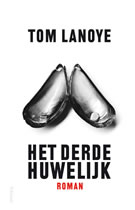Tom Lanoye
The Third Marriage (Het derde huwelijk)
Infinitely quotable and extremely enjoyable
‘And what isn’t useful, simply disappears. No questions asked.’ Het derde huwelijk (The Third Marriage), Tom Lanoye’s sixth novel, opens with this hard truth; hard because Maarten Seebregs, the main character, is not a ‘useful’ person.
He is dying, his work as a location scout for films has been taken from him, and the only things that remain are painkillers and recollections of his deceased lover. And then an opportunity to be of use, just one more time, comes from out of the blue. A stranger offers him a large sum of money to enter into a marriage of convenience with his girlfriend, African refugee Tamara. Maarten hesitates, but not for long.
In eight chapters, Lanoye tells the story from the point of view of Maarten Seebregs, who sees the world as if through a camera lens, making The Third Marriage a very cinematic novel. Each chapter is composed of a single scene: meeting Tamara for the first time; the day she moves in; a visit by the Immigration Department inspectors; an encounter with Maarten’s previously callous father now mellowing with age. And the moment at which things start to get out of hand: when a second refugee moves in with Maarten. According to Tamara, Phillip is her brother, but Tamara is not averse to a little white lie if it suits her purposes.
The book reads like a tragicomedy, seasoned with criticism of such things as the dumbing down of television and the petty bourgeoisie in trendy urban quarters. Maarten is a gifted grouser with a dark sense of humour and nothing escapes his mockery. Yet there is room for beauty too, most particularly in Maarten’s memories of his deceased lover.
Walking a tightrope between slapstick and drama, journalism and opera, Lanoye has written an extremely topical novel which highlights social decline, migration, Europe’s future, problems with young immigrants, and racism. He manages to avoid clichés rather elegantly, even when Maarten and Tamara are verbally abused by immigrant youths in a tram. As this particular exchange continues, the aggressors prove to be just as human and tragic as their victims.
In the up-tempo The Third Marriage, Lanoye also treats the reader to more of the splendidly recalcitrant definitions that litter all of his prose, a fine example being ‘migration is only a form of Darwinism.’
Publisher
Prometheus
Herengracht 540
NL - 1017 CG Amsterdam
TEL. +31 20 624 19 34
FAX +31 20 622 54 61
E-mail: [email protected]
Website: www.pbo.nl
Publishing details
Het derde huwelijk (2006, 337 pp)

Biography
Tom Lanoye (b. 1958) is one of the most popular and well regarded Flemish authors. He started out as a poet and a critic, but became famous with his prose, drama, politically and socially engaged columns and his performances. Abroad, particularly in Germany, he is highly regarded as a script writer. His debut as a fiction writer was Een slagerszoon met een brilletje (A Butcher’s Son with Glasses). After Alles moet weg (Everything Must Go, 1988, filmed in 1996), he established his reputation once and for all with Kartonnen dozen (Cardboard Boxes, 1991), an autobiographical novel about becoming aware of his homosexuality. His most important work until now, about the eventful nineties in Belgium, which Flemish television turned into a ten part series, was the award-winning Monstertrilogie (Monster Trilogy, 1997-2002). Het derde huwelijk (The Third Marriage, 2006) was nominated for the Libris Literature Prize and the Gouden Uil.
Quotes
This novel is the perfect synthesis of Tom Lanoye’s work and therefore the perfect introduction for those who are not yet familiar with his work. Lanoye introduces a deus ex machina at suitable moments and uses all manner of dramatic techniques that give his story a hellish tempo and suspense.
De Tijd
Once again this is a marvellous book, that makes you laugh out loud, shudder, and strikes you dumb. Literary juries note: praise this book, praise this man.
Elsevier
